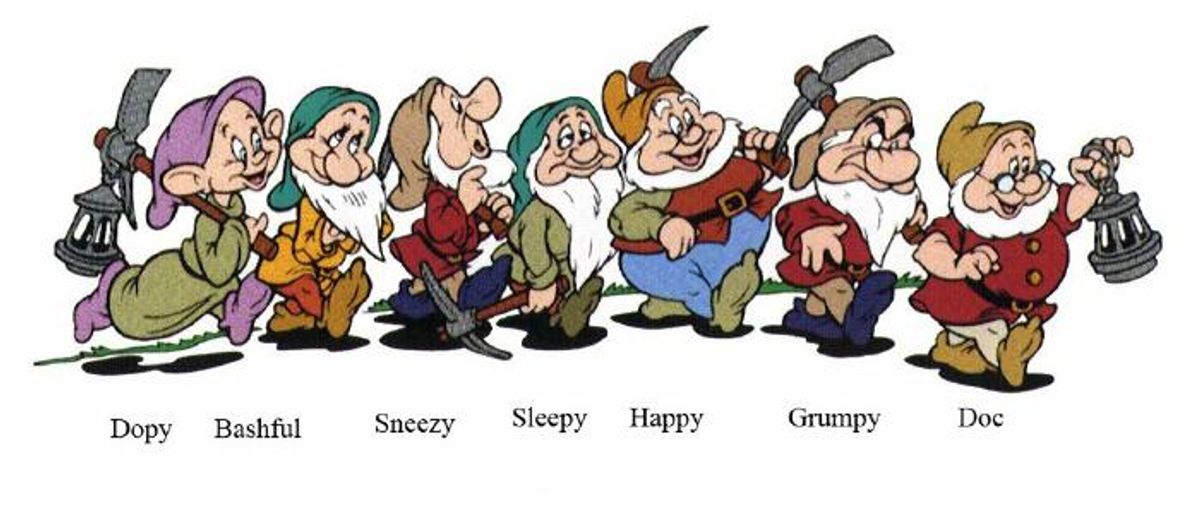Our fascination for associating wholesome, innocent icons of popular culture with hidden depravities and unsavory backgrounds seemingly knows no bounds. Thus we have tales that nature-loving pop singer John Denver was a Vietnam-era sniper, that genial children's TV host Fred Rogers served as a Navy SEAL, that the actor who portrayed geeky Paul Pfeiffer on TV's popular The Wonder Years grew up to become shock rocker Marilyn Manson, and that the host of Nickelodeon's preschooler favorite Blue's Clues died of a drug overdose.
As the epitomical producer of popular children's fare, Disney comes in for more than its fair share of such rumors: scandalous tales about both Walt Disney himself (e.g., that he was booted out of the military, that he was a Nazi sympathizer, that he was an illegitimate child) and many of the films produced by the company he founded.
A common motif among Disney legends is the claim that various Disney animated films were drug-inspired; that Disney and his band of animators were users of hallucinogens such as LSD, and their experiences with drugs formed the basis for such fare as the fantasy world of Snow White and the Seven Dwarfs, the colorful visual interpretation of musical themes in Fantasia, and the surreal psychedelia of Alice in Wonderland.
On a literal level, not much can be said to address these rumors other than to cite a litany of negative evidence. Walt Disney and his principal animators are well-known figures about whom much has been written, and no one who knew or worked with them claimed (or even suggested) that they partook of recreational drugs. And although drug abuse was enough of a social concern to prompt didactic scare films such as Reefer Madness and The Cocaine Fiends back in the 1930s, the "drug" of choice in Walt Disney's era was far more likely to have been alcohol than anything else. (Recall that the hallucinatory "Pink Elephants on Parade" sequence in 1941's Dumbo is triggered when the diminutive pachyderm inadvertently imbibes a tubful of champagne.)
As for LSD, it wasn't even brought to the USA until 1949, too late to have been the driving force behind Disney's classic animated films (although alternative hallucinogens such as mescaline were certainly obtainable.) Of the notion that the imagination displayed in Disney's animated films was drug-induced, animator Art Babbitt, who drew the dancing mushrooms in "The Nutcracker Suite" portion of Fantasia, sarcastically quipped: "Yes, it is true. I myself was addicted to
Drug rumors were undoubtedly fueled because Fantasia and Alice in Wonderland received mixed reviews upon their initial releases, and neither was much of a financial success until their
After [Fantasia's] 1969 rerelease proved a cult hit among college-age kids looking for a hallucinogenic experience, conservative groups began picketing movie theaters for screening Disney's animated "drug fantasies." Hippie-era moviegoers liked to sit in the front row, even on top of each other, smoking pot and offering advice to Mickey.
The company asked the theaters to promote the film not as typical Disney fare, but "now you sell Fantasia as you did
Easy Rider. Hip youngsters come to see it as a special kind of trip."Disney didn't exactly discourage the connotation. Psychedelic posters and other ad materials featuring Chernobog and the dancing mushrooms called it "The Ultimate Experience," while the promotional kit quoted one underground review: "Disney's Fantasia: A Head Classic: Representation of sound as color does resemble tripping on STD, LSD, THC and various other letters of the alphabet."
Long afterwards, fans continued to ask the animators if they were "on something" when they made [Alice in Wonderland]. It's not such an odd question, considering that all the things in the book and movie that suggest drugs: Alice ingests potions, wafers and mushrooms that change her size or alter her consciousness, her perspective constantly changes, she loses track of time, space and her own identity. There's the hookah-smoking caterpillar. In fact, the entire story, a dream framed by the "real world," might be seen as a hallucination or trip.
So, it wasn't surprising that in 1971 Alice in Wonderland was the top renting 16mm film in every college town across the country, playing to capacity crowds in heavy smoke-filled fraternity houses, university theaters, discos and private homes, where it sometimes ran over and over again for an entire weekend.
After the smash cult revival of Fantasia, Disney withdrew the 16mm prints of Alice and targeted a 1974 theater rerelease. The studio prepared ads with copy such as "Down the rabbit hole and through the talking door lies a world where vibrant colors merge into shapes of fantasy, and music radiates from flowers," "Nine out of ten Dormice recommend Walt Disney's Alice in Wonderland for visual euphoria and good, clean nonsense," and "Should you see it? Go ask Alice," a reference to Jefferson Airplane's song "White Rabbit."
Also of significance is that all the plot aspects of Alice in Wonderland which "suggest drugs" were present in Lewis Carroll's original work, and Disney merely adapted them for the screen.
As for the original example, Walt Disney didn't "invent" Snow White, of

